|
Horse trails through national wilderness areas get a bad rap
in certain circles, justifiably so in some cases. But it's
doubtful you will hear many complaints from people who fish
the Selway River above Lowell, Idaho. Without the guided
horseback excursions that take place in the Selway River
Valley there would likely be no foot trails for thousands
of trout fishermen wanting to explore the remote waters that
lay miles above the end of the lower Selway's access road.
There I was, at the 2007 FAOL Idaho Fish-In, following my Colorado
fishing buddies Bob and Dan Fike and Ken Sample as they hurried
along one of these horse trails. We were intent on finding some
remote places to fish, and we'd elected to hike some two miles
upriver beyond the last public parking spot.
The chemical components of horse tranquilizers are unknown to me,
but after hiking this trail I can better understand why some horsemen
keep a stash of these pills handy for times when the difference between
living or dying hinges on whether "Trigger" is adequately chilled out.
I can't imagine what a trail horse goes through when walking this trail,
burdened as trail horses often are by 200 pounds of nervous, squirming
"sport." But after hiking this trail I can report that places along
it are so precarious that straying off the path a mere two feet is a
major career blunder, one that will send you tumbling 150-feet almost
straight down a mountainside. Upon impact, your body will crunch onto
boulders or splash into the river.
"Keep your eyes focused on the back of the man walking directly ahead
of you," I told myself (the man in this case being Bob Fink). "Don't
look down; it'll give your feet an excuse to follow your gaze."
I wanted so much to stop for just a second and shoot for posterity
a photo of the astonishingly beautiful Selway, a National Wild and
Scenic River. But I learned years ago while using binoculars to inspect
bald eagle nests on the Kansas River by canoe, that it's all too easy
to lose your sense of balance when peering through optics while your
body is in motion. Here on this horse trail that concern might be
unfounded; nevertheless, I was worried that even if I stood stock
still the simple act of looking through my camera's viewfinder could
cause me to lose my balance and fall.
My three partners today were the fishing buddies who'd adopted me
soon after my arrival at Three Rivers Resort. Bob and Dan Fink
and Ken Sample have been trout fishing many years and the comfortable,
well broken-in condition of their wading gear proves it. Me, on
the other hand...I'd brought to Idaho a pair of stiff, virtually new
wading boots. The prospect of hiking two miles, then struggling
across whatever rocks and boulders we would inevitably encounter
upon locating a fishing spot, and then hiking two miles back to
my pickup...well, call me a weenie if you wish; you'll be exactly
right. Yours truly was hiking this trail in running shoes.
But even in this lightweight attire I was getting left in the
dust by three guys wearing chest waders and felt boots. What's
up with this, I wondered? Okay, I might be 60 years old, one
foot on a banana peel and the other in the grave. But up ahead
strides Bob, a man older than me, and...the distance separating us
keeps increasing?
"You gotta remember," explained Ken later, "the three of us live
in the Colorado Rockies at an elevation of around 8,500 feet? Here
at Lowell it's only 1,500 feet. To us, hiking in a place like
this is like having your car engine fitted with a supercharger."
The 2-foot wide horse trail eventually led down off the mountain
flanks to a big gravel bar. Upriver from it lay a rapid so
picturesque that it brought to mind those animated, twinkling
Hamm's and Coors beer signs we old guys, when we were kids, used
to see mounted on the walls of pool halls and beer joints everywhere
decades ago.
Below this rapid lay a wide, deep pool some 125 yards long. Its
volume flowed slowly past the big gravel bar before the streambed
shallowed and the pool's tailwater funneled into the next rapid
downstream.
The day before, I'd fished the Lochsa River first with Ken as my
partner and then Bob. On the Lochsa, Dan and I had been separated
by the serendipity of independent fisherman movement. Today, then,
I wanted to tag along with Dan everywhere he fished and do my best
to stay out of his way so that I could study how he works water
like this.
I was put at ease hearing my buddies remark repeatedly on how big
and wide the Selway is even two miles beyond road's end. They'd
never fished it this high up and expected the channel to be lots
narrower by now. Gaping at this majestic valley with a Midwesterner's
eyes, it struck me that you might need to hike a little bit farther
east - oh, like maybe somewhere off in North Dakota - before this
river gets any narrower. On the hike in, we'd come past pools on
the Selway that are so long, wide and deep that a Navy cruiser can
be floated in them with room to spare all the way around.
Dan got his rod rigged first, and stepped to the mound for the game's
first pitch. As he did so I moved into photo shoot position. Good
thing, because on his very first throw - a cast targeting pool center
at the tailout - his "Flymph" fly barely touched the water when it
got smacked hard by a good-sized cutthroat.
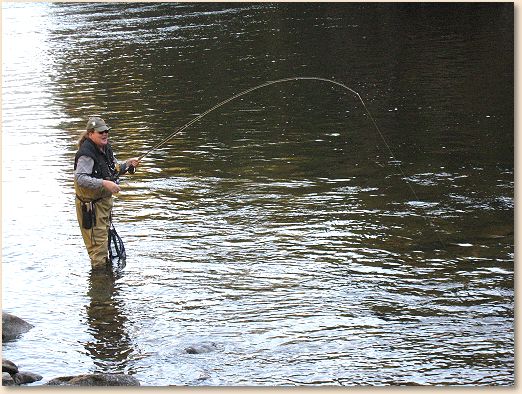
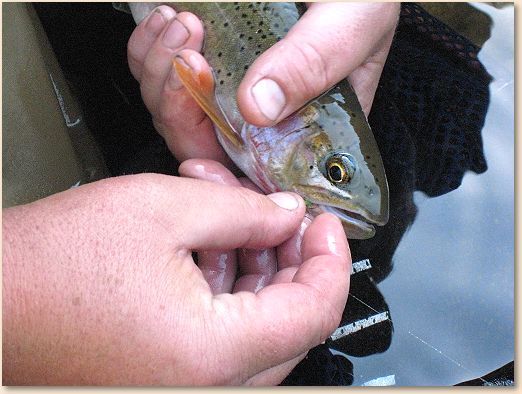
The party - or so we thought - was on! We split up into pairs,
Bob and Ken going upriver while Dan and I stayed at the pool.
But everyone's hopes for a period of hot action fizzled as minute
after minute ticked away with nobody getting a strike despite
the fact that each guy was using a different fly.
Dan finally conceded the obvious: another hit wasn't going to
happen here. He reeled in and headed downriver, pausing
occasionally to fish pocket water in the rapid's boulder garden.
Here is where I thanked my lucky stars that I was wearing running
shoes.
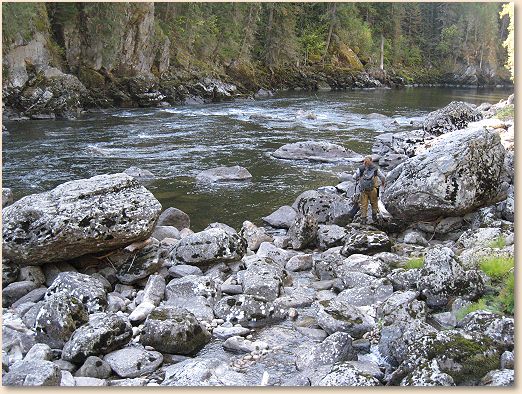
This photo fails to do justice to the physical challenges one
must overcome to move through a boulder field such as this. How
Dan managed to get through with such apparent ease, burdened as
he was with chest waders and boots, was an amazing thing to witness.
And even here, despite my lighter footwear I was consistently left
behind.
Unlike a day earlier on the Lochsa River, when an invigorating
morning dip had delayed the start of my fishing, today on the
Selway I restricted myself to dry land. Not the usual thing a
trout fisher does, I admit, but it let me get with the program
only minutes after Dan began fishing. Again, I'd decided to
trail him everywhere he went, not wanting to lead the way. Now,
if I had a clue what to do in water like this I might have
leapfrogged ahead of him as river fishing partners typically do.
But I knew my own best chance for success was having the guy in
the know be the first to go.
We thus proceeded downriver into the heart of the outflow rapid,
Dan in the lead and staying with his "Flymph" pattern. I went
with a #12 hi-visibility Parachute Adams; in rapids and bouncing
water I love this fly's bright little highway flare topknot that
lets me track its whereabouts as it scoots along the surface.
I might love a Parachute Adams but right now the trout didn't think
very highly of it. By the time I trailed Dan through the rapid's
boulder garden neither he nor I had caught a single fish or had
even one rise. Two good trout flies, zero fish. I finally reached
the pool below the rapid - deep, slow water where presumably a
Parachute Adams would not be a good choice. The cogs in my brain
began turning.
"Okay, here's a deep pool. Trout must live in this pool, and if
they don't want to eat an Idaho-type dry fly I'll just have to 'go
Kansas' on 'em."
This I did by clipping off the Parachute Adams and tying on my
Sweetheart of sweetheart flies - "Old Reliable," a #10 flashback
Hare's Ear Nymph. Then over and over I swam Old Reliable through
different parts of the pool, using assorted presentations at
various depths. If Old Reliable was detected by the fish inhabiting
this pool they were ignoring him utterly.
I yelled to Dan, who was standing a ways downstream, asking if he'd
caught anything yet. He shook his head no. He was working this
second pool's tailwater where a portion of the Selway's volume
angles across a gravel bar and gets squeezed into a narrow,
high-speed chute.
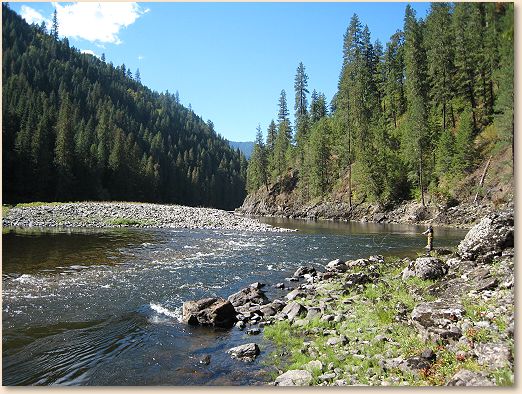
I reached this spot myself about five minutes after Dan abandoned
it to fish the pool immediately below the run. Still no hits on
his Flymph, my Adams Parachute had failed to open and even Old
Reliable was in the dog house. Is there anything in my box that
might catch a fish here?
This is where our day got saved by something Dan had told me 48-hours
earlier, minutes after I'd arrived at Three Rivers Resort. I'd asked him,
Bob and Ken to inspect my fly box and give me their honest opinions:
can any of the flies I've brought from Kansas catch trout in the
Lochsa and Selway?
I was not surprised when they politely pointed to very few of them
as possible winners. But now I recalled one in particular, a longish
orange and brown wiggle-legged fly that Dan had noticed. I've always
called it a centipede imitator and in Kansas have caught largemouth
bass with it. (Its correct name is Pete's Rubber Legs.) Dan told me
it's a fair imitation of a stonefly nymph and as such might prove
useful because stone flies do reside in the Lochsa and Selway rivers.
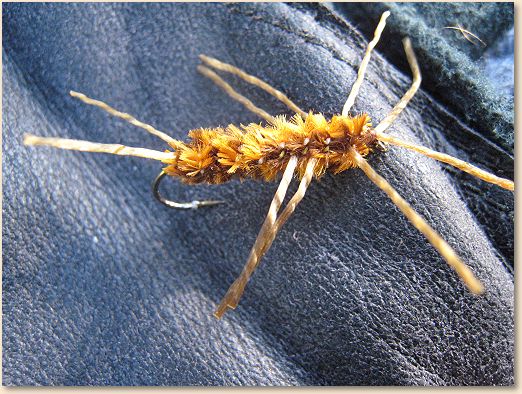
To me, it was not so much the insect species it represents but
the weight of Pat's Rubber Legs that persuaded me to retire the
lighter-weight Old Reliable and switch to "Plan C". The deep,
fast chute below this angled gravel bar demanded the heaviest
nymph in my box, one that would sink quicker and thus pass closer
to the riverbed, where any trout holding there might spy it. You
know, try to make mealtime a little easier for the fish? We nymph
fishermen are nothing if not helpful.
And it worked, too, just not where and how I thought it might.
What happened was I cast the PRL into the water just above the
drop so that the nymph could "pre-drop" a few inches before it
got swept into what I thought was the chute's sweet spot? The
nymph dutifully sank then shot through the chute (attracting no hits).
Farther downstream the current pulled my line tight and this swung
the nymph over alongside the bank. But instead of immediately
pulling it out for the next cast I let the nymph hang there close
to the bank in the eddy slot, where it began sinking deeper yet.
(The water there looked very shallow, but I knew better.) Only
then did I begin swimming it back toward me using 6-inch strips.
Crunch! came a hit. After a brief fight I landed an 8-inch cutthroat
trout. Yelling down at Dan to alert him to my bent rod, after releasing
this fish I hollered down at him again and told him which pattern I'd
used. Then on the very next cast, after repeating the above tactic I
had another strike but missed the fish, and I told him about that, too.
Dan by now was burned out on not getting any hits. I knew his fly
box held at least one PRL because he'd showed it to me earlier. So
he retired his Flymph, tied on a Pat's Rubber Legs, promptly got
a strike and landed a nice cutthroat. And then another. We'd
finally hit on a pattern the fish liked.
The valley wall went vertical just below where Dan was standing.
Soon he abandoned the spot for lack of any more downriver options
and walked past me with intentions of fishing his way back upstream
through the first rapid and then on to the gravel bar where our 4-man
group had arrived earlier. Once he vacated his place at the end of
the line I moved down there and took it over. For my effort I caught
an 8-inch trout that I initially thought was a rainbow. (But later
that night after describing its coloration, length and body markings
to my FAOL campground mates, they concluded that it was not a true
mountain rainbow but instead a steelhead smolt; that is, a baby seagoing
rainbow trout.)
Soon I followed Dan back upstream. And I didn't follow simply
to continue observing his fly fishing skills. There is something
about finding yourself alone in the Selway River's imposing
boulder-infested stretches, alone even for a few minutes, that
makes you want to stay in constant contact with another person.
Lose your footing here and suffer a bone-breaking knockout fall
in amongst those SUV-size boulders and nobody sees you go down,
if nobody knows where in the world you disappeared to, it could
take a rescue party hours, perhaps days to find you. The Wild
and Scenic Selway River is more than intimidating, more than humbling.
It's beautiful as all get-out, but the place is sorta spooky if you
ask me.
Once we got back to the big gravel bar (I took an easier, higher
route across smaller rocks while Dan took the ultra-craggy boulder
route alongside the river channel, and still he beat me back!) we
commenced working the big pool again, both of us still casting the
"Fly of the Day." Dan picked up another cutthroat at the pool's
tailwater almost in the exact spot where two hours earlier he'd
scored using his Flymph.
For the first time all day I leapfrogged him, forty yards maybe,
so that I could work the pool at a point higher upstream. Almost
immediately my PRL took a hit, which I missed. I could see a fish
swimming behind the fly, mouthing it repeatedly until my retrieve
brought the nymph into water so shallow that the fish broke off
its harassing pursuit.
Whether this was the same fish I caught about 30 casts later, who
knows? I didn't care; it just felt good catching a beautiful
cutthroat trout while standing on that big, open gravel bar with
no boulders or mountain walls crowding me.
Here's how it happened: For about ten minutes Dan had been giving
off body language indicating he thought it time for us to leave.
I, too, felt it was getting late in the day. So I took it upon
myself to quit first. While absent-mindedly retrieving my last
cast using plain-Jane turns of the reel handle, Murphy's Law paid
a visit in the form of a 12-inch western cutthroat that apparently
prefers a crude presentation to the finesse version.
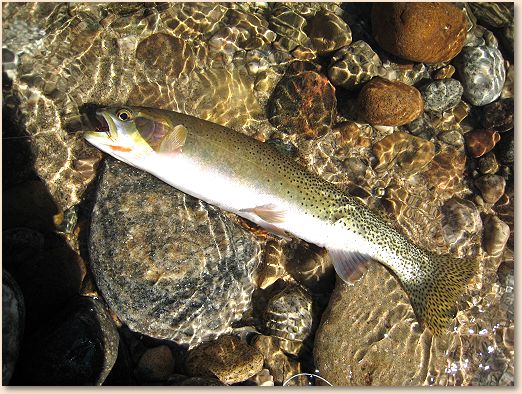
This fish kept our noses to the grindstone a while longer, but
not much. We hadn't seen Bob or Ken since our teams split up.
Dan said it was likely they'd already hiked back to the jump-off
point. I agreed. So we left and sure enough, Ken and Bob were
waiting for us at the parking area.
Driving back down the valley road to Three Rivers Resort, foremost
in my mind was not the great fun I'd just had catching and releasing
four trout; instead, it was the sheer, overwhelming presence of the
Selway. While spending only a few hours amidst a tiny sampling of
this huge, raw country I'd began feeling for the first time in my
life a gut-level respect for the courage and toughness of the Lewis
and Clark Expedition. That small group had visited this river long
ago, following no roads, using no motorized vehicles. They'd come
to this forbidding valley supported by very few supplies and they
came despite the constant risk of life-threatening disease and injury.
They entered this valley and many others knowing that a violent encounter
with a grizzly bear could happen around the next tree or boulder ahead.
And driving down the valley toward camp I felt also a deep sadness
for the wealth that has been taken from the Selway and the Lochsa
rivers; indeed, for the wealth that our nation of sport fishers
has had taken from us by the machinations of competing bureaucracies
and porkbarrel politics. Not that long ago, in the mid-twentieth
century before all the big dams got built on the Columbia River's
watershed, steelhead trout and wild salmon from the Pacific Ocean
migrated far up the Selway, the Lochsa and other Idaho rivers large
and small; they migrated even into the tiniest brooks that trickle
across upland hay meadows. Absent today's impassable man-made
obstructions these fish muscled their way through pools, rapids
and riffles in such boisterous, uncountable millions that history
records incidents where horse teams being led across river fords
would panic at the sight and gallop away in terror.
I was driving now beside this shadow, this echo of an endless
bounty that maps still call the Selway River, glanced down at
it when road conditions permitted and wondered, "What monstrous
thing have we done to this place? What are we doing?" ~ Joe
About Joe:
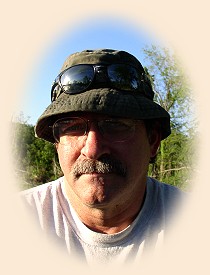 From Douglas County, Kansas, Joe is a former municipal and
federal police officer, now retired. In addition to fishing, he hunts
upland birds and waterfowl, and for the last 15 years
has pursued the sport of solo canoeing. On the nearby
Kansas River he has now logged nearly 5,000 river miles
while doing some 400 wilderness style canoe camping
trips. A musician/singer/songwriter as well, Joe recently
retired from the U.S. General Services Adminstration.
From Douglas County, Kansas, Joe is a former municipal and
federal police officer, now retired. In addition to fishing, he hunts
upland birds and waterfowl, and for the last 15 years
has pursued the sport of solo canoeing. On the nearby
Kansas River he has now logged nearly 5,000 river miles
while doing some 400 wilderness style canoe camping
trips. A musician/singer/songwriter as well, Joe recently
retired from the U.S. General Services Adminstration.
Joe at one time was a freelance photojournalist who wrote the
Sunday Outdoors column for his city newspaper. Outdoor
sports, writing and music have never earned him any money,
but remain priceless activities essential to surviving the
former 'day job.'
|







 From Douglas County, Kansas, Joe is a former municipal and
federal police officer, now retired. In addition to fishing, he hunts
upland birds and waterfowl, and for the last 15 years
has pursued the sport of solo canoeing. On the nearby
Kansas River he has now logged nearly 5,000 river miles
while doing some 400 wilderness style canoe camping
trips. A musician/singer/songwriter as well, Joe recently
retired from the U.S. General Services Adminstration.
From Douglas County, Kansas, Joe is a former municipal and
federal police officer, now retired. In addition to fishing, he hunts
upland birds and waterfowl, and for the last 15 years
has pursued the sport of solo canoeing. On the nearby
Kansas River he has now logged nearly 5,000 river miles
while doing some 400 wilderness style canoe camping
trips. A musician/singer/songwriter as well, Joe recently
retired from the U.S. General Services Adminstration.